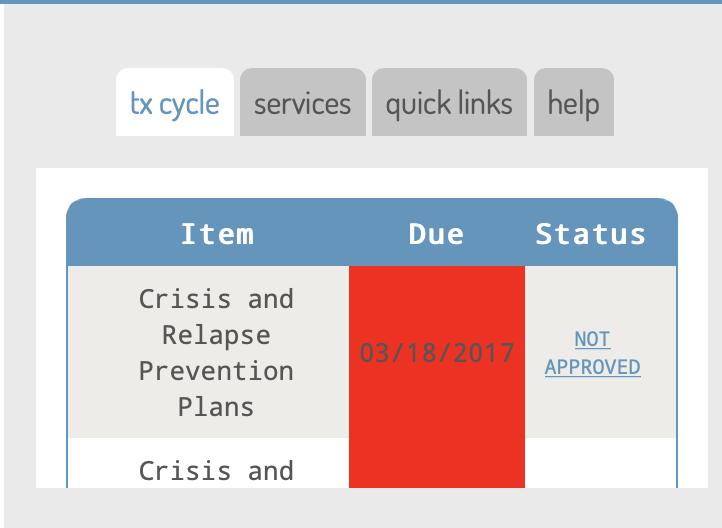You'll have a busy schedule here at Accend. This section provides a few tips for managing your time, meeting deadlines, and managing your caseload.
This section was published on November 26, 2020. Check back later for updates.
Time management, especially for those of you who provide home and community-based services, is a challenge at Accend. We have high expectations. One of those is that you manage your time and caseload to achieve certain target percentages spent providing services. To do that requires developing disciplined work practices and habits. These are some tips and tools for that.

What You Will Learn
- Use the Scheduler
- Set recurring appointments
- Document from scheduled services
- Document concurrently
- Use the Due Items list to meet or beat deadlines for assessment and planning
- Pay attention to eligibilty flags
- Use the service summary to monitor fidelity
- Respond to disengaged clients and seek guidance
- Manage your schedule for client cancellations
- Do what productive staff do
The TabsTM service scheduler is a valuable tool in managing your time efficiently. Develop and practice the following habits for using the Scheduler:
- Anytime you schedule an appointment, you have the option to make it recurring. Schedule repeating appointments with the people you serve. Setting regular appointment days and times is much more efficient than re-doing your schedule each week, and may improve consistent engagment.
- Document using your scheduled appointments. Don't start a new note from scratch.
- Document your availabilty in your open space each week to be scheduled to meet new referrals using the service type: "Open for Scheduling or Referral." This will save you and intake interviewers time and improve responsiveness to referrals.
Concurrent Documentation
Concurrent documentation is not just a rule, it is a best practice. Read the deinition and requirements for concurrent documentation in the Documentation Guide here. Documenting concurrently saves time (not just for you, but for your supervisor who approves your notes) and improves accuracy. It is an important time management tool and good stewardship.
Meeting Deadlines
You'll face frequent deadlines in your work. Manage these deadlines by being proactive. There is no penalty for turning things in early, and missing deadlines can cause interruptions in services or can effect you productivity when you provide services that are out of complance with deadlines. Submitting assessment and planning work on or after the deadline also reduces the quality and consistency of the support your supervisors can provide to you if they are rushing to stay in compliance.
Due Items
Your Due Items list appears on your home screen each time you log into TabsTM. (If you have certain supervisory/administrative access, you'll have to tap on the link to view it.)
Don't rush past your Due Items list. Stop and take a look. All upcoming due dates for required assessments and plans for each person you serve are listed there. The dates are color-coded to help you manage them. Here are what the colors mean:
| Color |
What it Means |
| RED |
This item is overdue. If you're still seeing that person, you need to get this done immediately. If you're not still seeing this person, you need to visit with your supervisors about taking them off your assignment list, or closing them if you've lost touch. |
| ORANGE |
This item should be in complete status, awaiting your supervisor's review. It is due for approval in less than one week. |
| YELLOW |
You should be making good progress on this item. It is due in less than one month. |
| BLUE |
This item is coming due in under two months. Time to get started. |
| GREY |
You're ok for now unless someone you serve needs an update becuase of significant progress, lack of progress, lor signifant life changes. |
Glance Tabs

The Glance Tabs on the right hand side of your screen are also there to help you meet deadlines each time you open the file for someone you serve. In the example to the left here, you can see that Tess has a Crisis and Relapse Prevention Plan due. It's been submitted and reviewed by a supervisor, but its in Not Approved status. That means you've been asked to make some edits or corrections.
Eligibility Flags

If there's an assessment, service plan, or other document due for someone you serve, you'll also receive an Eligibility Flag at the top of your Progress Note. Don't ignore these flags. Tap on the flag to see what's due.
Never Ignore Due Items!
We hear too often that team members ignore Due Items and Eligibility Flags because they thought theu were wrong. Don't do this! If you think you have an incorrect Due Item, there is still a problem and action is required of you. Either you're mistaken and it is due, or there is an inaccuracy in the record. It's your job to keep your records accurate and up-to-date. Investigate, ask, get it corrected.
Service Fidelity and Engagement
Service fidelity means providing the services we promised in the Treatment/Service Plan. Each Plan desribes medically necessary services. If your plan calls for two visits per week, you must make every effort to make two visits per week. If your plan calls for 1.5 hour appointments, you must schedule these visits for 1.5 hours.
If, during the course of treatment, people you serve indicates that they do not want services at the frequency and duration in the plan, or feel they need more because of events or circumstances in their live report this to your supervisor and modify the plan.
Using the Service Summary

The Service Summary is an under-used tool in TabsTM.
You have a link to this tool on your home page in TabsTM. Tap on it and then select a time period and the person or persons for whom you would like to see a summary. It looks like the image on the left (names removed).
In this example, you can seen that the first five individuals received ARMHS within the range of what was planned.
Four others received services, but short of what was planned. And the total effort (services provided + cancellations) for each was short of what was planned as well.
There was effort to deliver services to final person on the list, but these were cancelled.
There is some work needed here. This particular example only examines one week, but if these patterns contined over an extended period of time, these cases should be discussed in monthly supervision.
Disengagement
We use the terms engagement and disengagement to refer to an individual's level of participation in the services we offer. We view engagement in this way: when the services we provide meet people's needs, they will engage. When individuals perceive that services are not meeting their needs, they disengage. It's that simple.
Many factors influence this, but the one factor that most significantly impacts it is your relationships with the people you serve. When individuals you work with do not engage, or disengage, we ask that you use the window and mirror concept (discussed in our Mission Guide, here. These are just some of the questions you might ask yourself:
- Have I been person-centered and responsive to the individual's needs?
- In each treatment session, do I use skills such as reflective listening, open-ended questions, and rolling with resistance to let the individual guide and set priorities for each session?
- Do I demonstrate unconditional positive regard for the individual at all times?
- Are the services I am providing meeting his or her needs? Am I asking this question often and listening carefully to the full answer, exploring the nonverbal and other signals that might indicate there is more to it than the often polite response?
- Are the goals and objectives in the plan still the person's goals and objectives? Have his or her needs and priorities changed?
- Have events or circumstances in the individual's life changed, necessitating a potential change in the current plan?
- Have I been flexible and adaptive in response to events and circumstances in the lives of these individuals?
- Is there someone else providing services to this person who can explore these questions with him or her to learn more, to whom I can look for help or insight?
- Am I the best person, with the right set of skills, to meet this person's needs at this time?
Procedures for Disengagement
Basic procedures for managing caseloads when individuals disengage depend on the circumstances and the service. See individual service guides or view a summary, here.
Engagement
Let's not just focus on what's not going well. In the service summar above, five individuals are participating in services at the levels planned. Caseload management, and analysis of engagement should also celebrate success!
While there are lessons to be learned in the window-and-mirror exercise when examining disengagement, there are also many to be learn in examining success. Do this simultaneously. Here are a few possible probes for that process:
- What are the elements in my relationships with engaged individuals that look different from those who are not engaged?
- What are the strengths I possess that have led to effective engagement with these individuals?
- Is there more evidence of treatment progress in these cases (indicating that the plan is well-targeted on individual needs)?
- Are there patterns of personalities, interests, needs, and subgroups that I seem to more effectively engage with and make progress?
- Do I feel differently about these relationships? How? Is that a factor?
- How to the needs and treatment priorities of highly engaged individuals differ from those less engaged? Am I more effective in certain circumstances relating to the needs of the people I serve?
- Are there others who work with these individuals who can provide insight on why these relationships are particularly effective?
Our most effective team members analyze these factors, and their own strengths and weaknesses well, sometimes intuitively rather than analytically. And they build on their strengths to build caseloads where they can be most effective.
Cancellations are inevitable for many reasons. Our most productive staff handle cancellations using strategies like these:
- They set recurring appointments
- They treat frequent cancellations by an individual as a clinical (engagement) concern and seek guidance.
- They coordinate well with coworkers on idividuals with inconsistent engagement.
- They know which individuals would be happy to see them at any time, and call them to offer an earlier appointment when someone else cancels.
- They fill their schedules with appointments knowing they can use cancellation time for their non-billable work like writing assessments and plans, completing training, etc.
This guide is a living document. We want to improve it with your help. Do you have questions? Found a typo? Find yourself wanting more information? Please send us your thoughts about anything in this chapter by tapping on the link below.




